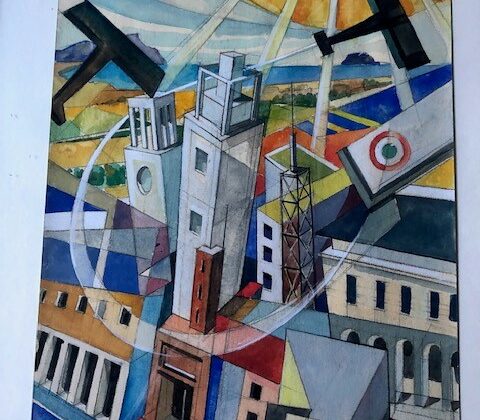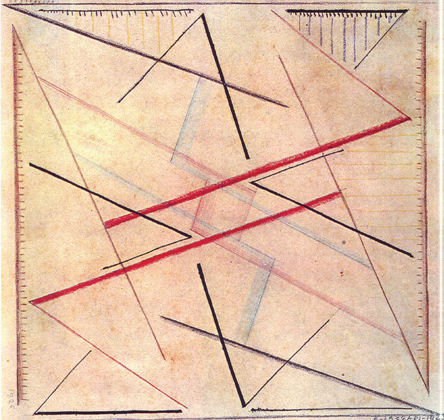Red Star over Russia
Francesco Carelli, University of Milan – Works by leading Soviet painters travel to UK for the first time showing life, art, propaganda and also the bad side.
Three large paintings which formed the basis for the magnificent centerpiece of the USSR pavilion at the 1937 World Fair have travelled to the UK for the first time to
feature in Red Star Over Russia at Tate Modern.
These dramatic paintings, on loan from the Perm State Art Gallery in central Russia,
are a prime example of Soviet socialist realism.
The ‘Exposition Internationale des Arts et Techniques’ in Paris provided a stage for the Soviet Union to promote its artistic and cultural achievements to the world. Created by Boris Iofan, the pavilion was designed in the modernist style and featured statues of political leaders, models of automobiles, and was crowned by a 24m-high steel sculpture of a pair of workers bearing the hammer and sickle. The pavilion culminated in a vast mural by designed to commemorate the twentieth anniversary of the October Revolution and depicts a parade on Red Square of proud Stakhanovite
workers, who set records for productivity and were glorified by the Communist government as part of Stalin’s campaign to radically transform agriculture and industry. The mural was destroyed when the exhibition ended, and all that remains are oil paint studies.
The manuscript for an unpublished book of revelatory photographs depicting life in Russia – created in 1932 at the early stage of Stalin’s reign of terror and mysteriously never printed – goes on public display for the very first time as part of Red Star Over Russia.
David King recovered the mock-up for this unique collection of vintage photographs in the 1970s, tracking it down to a Dutch publishing house after hearing rumours of its existence. It remains one of the most remarkable objects in his outstanding collection of Soviet artefacts.
Entitled Russia: How it Was, What it Became, How it Is, the book documents the political and social conditions in Russia from the late-nineteenth century to the Civil War through 450 documentary photographs, revealing what life was like behind the veil of propaganda. The spreads depict a variety of aspects of life in the USSR, from the Bolshevik’s coup of Petrograd and the Red Army celebrating the fall of the Tsar, to Soviet architecture and oil fields in Azerbaijan. They show how photographers were at the forefront as turbulent events unfolded, taking to the streets to record history.
A highlight of Red Star Over Russia is Adolf Strakhov’s iconic Emancipated Woman: Build Socialism!, a poster created for International Women’s Day in 1926 which became an emblem of female emancipation in the Soviet era. It depicts a female worker in a powerful stance outside a factory holding the red revolutionary flag. The 1917 Revolution saw the beginning of a campaign to pioneer the liberation and social engagement of women in the Soviet Union. Graphic designers were instrumental in promoting the movement towards equal rights in a post revolutionary
society, devising the figure of the heroic female worker as a symbol of the ideal communist woman. This motif appeared repeatedly in political posters throughout the 1920s. In Strakhov’s dramatic design she is rendered in striking red and black in the style of monumental sculpture, glorifying the working-class. This image would have been displayed in public squares, factories and homes across the country, filtering into the lives of tens of millions of citizens.
Drawn from the remarkable collection of the late graphic designer David King (1943 – 2016) the exhibition offers a visual history of Russia and the Soviet Union and
reveals how seismic political events led to the social transformation that inspired a wave of innovation in art and graphic design across the country.
Throughout his lifetime David King assembled one of the most comprehensive collections of Russian and Soviet material in the world, consisting of over a quarter of a million artefacts by famous and anonymous photographers, artists and designers. Featuring over 250 posters, paintings, photographs, books and ephemera, many on public display for the first time, Red Star Over Russia is a rare opportunity to explore this unique collection. It provides a chance to understand how life and art were transformed during a momentous period in modern world history, and see how artists such as El Lissitzky, Aleksandr Rodchenko and Nina Vatolina captured the revolutionary hopes of a nation in an extraordinary outpouring of visual material.
The exhibition explores how new popular art in the form of posters, periodicals, leaflets and banners informed, educated and entertained the people, filtering into the everyday lives of tens of millions of citizens. One of the new propaganda tools developed by the Bolsheviks was ‘agitprop trains’, which were decorated with vivid
murals and travelled the country carrying public speakers, pamphlets, film shows and a printing press to disseminate the policies of the new government. Following the October Revolution, art was taken onto the streets in the form of street performances and pageants, monumental sculptures and propaganda posters, which were displayed on public squares, factories and inside people’s homes. The exhibition features striking
examples of posters by artists such as Adolf Strakhov, Valentina Kulagina and Dmitrii Moor, whose depictions
of heroic, industrial scenes and expressive use of typography captured the revolutionary fervour of the age.
In stark contrast, a further section of the exhibition is dedicated to the memory of the millions who perished in Stalin’s purges, uncovering some of the personal stories of
figures erased from history. It includes poignant prison mugshots of the people who lived in tumultuous times, such as Lenin’s closest allies Lev Kamenev and Grigorii Zinoviev, both executed on false charges, and poster artist Gustav Klutsis, whose works adorned the cities squares long after his execution in 1938.
Red Star Over Russia also reveals how images were manipulated during a period of widespread state censorship, as political figures were airbrushed from official photographs and images were montaged in order to celebrate the end of the Second World War.



